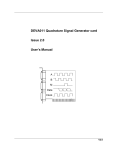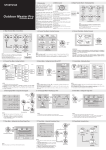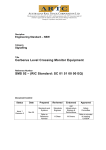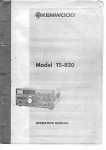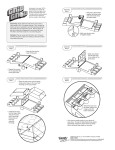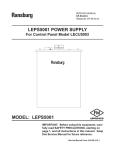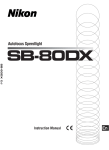Download Basic characteristics data • Instruction manual
Transcript
Basic Characteristics Data Basic Characteristics Data Model Circuit method Input module of ACE300F Input module of ACE450F Input module of ACE650F Input module of ACE900F Output module A-K Output module 2A-2K Output module L,M,N,P,R Output module Y,W,Z,9,Q,V Output module S,T,U Active filter *1 *2 *3 *4 *5 *6 *7 Switching frequency Input current [kHz] [A] 80 Rated input fuse Series/Parallel PCB/Pattern Inrush current operation availability protection Material Single sided Double sided Series operation Parallel operation 3.7*1 250V 8A SCR FR-4 Yes No No Active filter 80 5.7*2 250V 10A SCR FR-4 Yes No No Active filter 80 8.0*3 250V 15A SCR FR-4 Yes No No Active filter 80 11*4 250V 20A SCR FR-4 Yes No No Forward converter 120 - - - FR-4 Yes Yes*5 Yes*7 Forward converter 120 - - - FR-4 Yes Yes*5 Yes*7 Forward converter 120 - - - FR-4 Yes Yes*5 No Forward converter 120 - - - FR-4 Yes Yes*6 No Forward converter 120 - - - FR-4 Yes Yes*6 No Input current is based on Model AC3-HEEC-00 outputs 250W at AC100V. Input current is based on Model AC4-HHECC-00 outputs 400W at AC100V. Input current is based on Model AC6-HHECC-00 outputs 600W at AC100V. Input current is based on Model AC9-HHEECC-00 outputs 800W at AC100V. Series operation is possible with the same output modules. Series operation is possible, but series bar cannot be set by the series code. Parallel operation is possible with the same output voltage module. ACE ACE ACE-8 ACE_E.indd 8 15.6.18 4:54:38 PM ACE300F OVER CURRENT CHARACTERISTICS RISE TIME & FALL TIME 25.0 +24V(H) +24V(H) DC Output 20.0 OUTPUT VOLTAGE [V] ACIN 100V IO = 100% +12V(E) +5V(C) +3.3V(B) AC Input 15.0 10.0 +12V(E) +5V(C) 5.0 +3.3V(B) 100ms/DIV 0 10ms/DIV 10 20 30 40 OUTPUT CURRENT [A] INRUSH CURRENT (AC3-HEEC-00) 10A/DIV INSTANTANEOUS COMPENSATION [ms] INSTANTANEOUS INTERRUPTION COMPENSATION (AC3-HEEC-00) INPUT VOLTAGE 100V 75 Frequency 60Hz Load factor 100% Input voltage AC100V 50 ACE 25 0 100 200 50ms/DIV 300 OUTPUT POWER [W] INPUT HARMONIC CURRENT AC100V (AC3-HEEC-00) INPUT HARMONIC CURRENT AC230V (AC3-HEEC-00) 10 Harmonic current standard class A (at odd number) HARMONIC CURRENT [A] HARMONIC CURRENT [A] 10 Output power 250W Input voltage AC100V 1 0.1 0.01 0.001 Harmonic current standard class A (at odd number) 1 Output power 300W Input voltage AC230V 0.1 0.01 0.001 0 10 20 30 40 0 10 HARMONIC ORDER 20 30 40 HARMONIC ORDER EFFICIENCY (AC3-HEEC-00) POWER FACTOR & INPUT CURRENT (AC3-HEEC-00) 1.0 ACE 85.0 8 6 5 0.8 INPUT CURRENT 4 0.7 Output power 250W Output power 125W 3 2 0.6 80.0 EFFICIENCY [%] POWER FACTOR POWER FACTOR INPUT CURRENT [A] 7 0.9 75.0 70.0 65.0 Output power 250W Output power 125W 1 0.5 60 100 140 180 220 INPUT VOLTAGE [V] 260 0 300 60.0 60 100 140 180 220 260 300 INPUT VOLTAGE [V] ACE-9 ACE-9 ACE_E.indd 9 15.6.18 4:54:38 PM ACE450F OVER CURRENT CHARACTERISTICS RISE TIME & FALL TIME 25.0 +24V(H) +24V(H) 20.0 DC Output OUTPUT VOLTAGE [V] ACIN 100V IO = 100% +12V(E) +5V(C) +3.3V(B) AC Input 15.0 10.0 +12V(E) +5V(C) 5.0 +3.3V(B) 100ms/DIV 0 10ms/DIV 10 20 30 40 OUTPUT CURRENT [A] INRUSH CURRENT (AC4-HHECC-00) ACE 10A/DIV INSTANTANEOUS COMPENSATION [ms] INSTANTANEOUS INTERRUPTION COMPENSATION (AC4-HHECC-00) INPUT VOLTAGE 100V 75 Frequency 60Hz Load factor 100% Input voltage AC100V 50 25 0 100 200 300 50ms/DIV 400 OUTPUT POWER [W] INPUT HARMONIC CURRENT AC100V (AC4-HHECC-00) INPUT HARMONIC CURRENT AC230V (AC4-HHECC-00) 10 Harmonic current standard class A (at odd number) HARMONIC CURRENT [A] HARMONIC CURRENT [A] 10 Output power 400W Input voltage AC100V 1 0.1 0.01 0.001 Harmonic current standard class A (at odd number) 1 Output power 450W Input voltage AC230V 0.1 0.01 0.001 0 10 20 30 40 0 10 HARMONIC ORDER ACE 20 30 40 HARMONIC ORDER EFFICIENCY (AC4-HHECC-00) POWER FACTOR & INPUT CURRENT (AC4-HHECC-00) 1.0 85.0 8 7 6 5 0.8 INPUT CURRENT 4 0.7 3 2 0.6 75.0 70.0 65.0 Output power 400W Output power 200W 0.5 60 80.0 EFFICIENCY [%] POWER FACTOR INPUT CURRENT [A] POWER FACTOR 0.9 100 140 180 Output power 400W Output power 200W 1 220 INPUT VOLTAGE [V] 260 0 300 60.0 60 100 140 180 220 260 300 INPUT VOLTAGE [V] ACE-10 ACE_E.indd 10 15.6.18 4:54:39 PM ACE650F OVER CURRENT CHARACTERISTICS RISE TIME & FALL TIME 25.0 +24V(H) +24V(H) 20.0 DC Output OUTPUT VOLTAGE [V] ACIN 100V IO = 100% +12V(E) +5V(C) +3.3V(B) AC Input 15.0 10.0 +12V(E) +5V(C) 5.0 +3.3V(B) 100ms/DIV 0 10ms/DIV 10 20 30 40 OUTPUT CURRENT [A] INRUSH CURRENT (AC6-HHECC-00) 20A/DIV INSTANTANEOUS COMPENSATION [ms] INSTANTANEOUS INTERRUPTION COMPENSATION (AC6-HHECC-00) INPUT VOLTAGE 100V 75 Frequency 60Hz Load factor 100% Input voltage AC100V 50 ACE 25 0 200 400 600 50ms/DIV 800 OUTPUT POWER [W] INPUT HARMONIC CURRENT AC100V (AC6-HHECC-00) INPUT HARMONIC CURRENT AC230V (AC6-HHECC-00) 10 Harmonic current standard class A (at odd number) HARMONIC CURRENT [A] HARMONIC CURRENT [A] 10 Output power 600W Input voltage AC100V 1 0.1 0.01 0.001 Harmonic current standard class A (at odd number) 1 Output power 650W Input voltage AC230V 0.1 0.01 0.001 0 10 20 30 40 0 10 HARMONIC ORDER POWER FACTOR & INPUT CURRENT (AC6-HHECC-00) 1.0 30 40 EFFICIENCY (AC6-HHECC-00) 82.0 0.8 INPUT CURRENT 6 0.7 4 EFFICIENCY [%] 8 INPUT CURRENT [A] 10 POWER FACTOR ACE 84.0 12 0.9 POWER FACTOR 20 HARMONIC ORDER 80.0 78.0 76.0 74.0 0.6 2 Output power 600W Output power 300W 0.5 60 100 140 180 220 INPUT VOLTAGE [V] 260 0 300 Output power 600W Output power 300W 72.0 70.0 60 100 140 180 220 260 300 INPUT VOLTAGE [V] ACE-11 ACE-11 ACE_E.indd 11 15.6.18 4:54:39 PM ACE900F OVER CURRENT CHARACTERISTICS RISE TIME & FALL TIME 25.0 +24V(H) +24V(H) DC Output 20.0 OUTPUT VOLTAGE [V] ACIN 100V IO = 100% +12V(E) +5V(C) +3.3V(B) AC Input 15.0 10.0 +12V(E) +5V(C) 5.0 +3.3V(B) 100ms/DIV 0 10ms/DIV 10 20 30 40 OUTPUT CURRENT [A] INRUSH CURRENT (AC9-HHEECC-00) ACE 20A/DIV INSTANTANEOUS COMPENSATION [ms] INSTANTANEOUS INTERRUPTION COMPENSATION (AC9-HHEECC-00) INPUT VOLTAGE 100V 75 Frequency 60Hz Load factor 100% Input voltage AC100V 50 25 0 250 500 750 50ms/DIV 1000 OUTPUT POWER [W] INPUT HARMONIC CURRENT AC100V (AC9-HHEECC-00) INPUT HARMONIC CURRENT AC230V (AC9-HHEECC-00) 10 Harmonic current standard class A (at odd number) HARMONIC CURRENT [A] HARMONIC CURRENT [A] 10 Output power 800W Input voltage AC100V 1 0.1 0.01 0.001 Harmonic current standard class A (at odd number) 1 Output power 900W Input voltage AC230V 0.1 0.01 0.001 0 10 20 30 40 0 10 HARMONIC ORDER ACE 20 30 40 HARMONIC ORDER EFFICIENCY (AC9-HHEECC-00) POWER FACTOR & INPUT CURRENT (AC9-HHEECC-00) 1.0 85.0 16 12 10 0.8 INPUT CURRENT 8 0.7 6 4 0.6 75.0 70.0 65.0 Output power 800W Output power 400W 0.5 60 80.0 EFFICIENCY [%] POWER FACTOR POWER FACTOR INPUT CURRENT [A] 14 0.9 100 140 180 Output power 800W Output power 400W 2 220 INPUT VOLTAGE [V] 260 0 300 60.0 60 100 140 180 220 260 300 INPUT VOLTAGE [V] ACE-12 ACE_E.indd 12 15.6.18 4:54:39 PM AC-DC Power Supplies Configurable Type Instruction Manual 1 Ordering information ACE-14 2 Series operation and Parallel operation in Modular power supply ACE-15 3 2.1 Series operation ACE-15 2.2 Parallel operation ACE-15 Function 3.1 Input voltage range ACE-15 3.2 Inrush current limiting ACE-15 3.3 Overcurrent protection ACE-16 3.4 Thermal protection ACE-16 3.5 Overvoltage protection ACE-16 3.6 Output voltage adjustment ACE-16 3.7 Remote sensing ACE-16 3.8 Remote ON/OFF ACE-17 3.9 Isolation ACE-17 3.10 Alarm 4 5 ACE-15 Assembling and installation method ACE-17 ACE-18 4.1 Installation method ACE-18 4.2 Derating ACE-18 Option ACE-21 Option outline ACE-21 6 Input module ACE-23 7 Medical electrical equipment ACE-23 5.1 ACE ACE 7.1 Type ACE-23 7.2 Specification ACE-23 7.3 Others ACE-23 ACE-13 AC-DC Power Supplies Configurable Type 1 Ordering information 6 5 4 slot Instruction Manual lPART NUMBERING EXAMPLE (1) AC9 OHHECC 01 08GW Refer to options G W 3 2 1 code H-module available in serial connection at 24V 6.5(8)A, or 48V 6.5(8)A C-module available in parallel connection at 5V 46.8A E-module 12V 13(14)A code AC ACE300F 3:ACE300F ACE450/650F 4:ACE450F ACE900F 6:ACE650F 9:ACE900F Start from Slot1 Parallel code Option Series code (”00” if parallel operation (Blank if not required) is not required.) Blank panel Unit ACE900F (Lower voltage to higher voltage. If a module is not required, set ”0” for the slot.) Choose from Table1.1. Series bar Shorted bar lPART NUMBERING EXAMPLE (2) If the parallel operating module C (5V, 46.8A) in example (1) is changed to module 2C(5V, 60A), the part number would change to AC9-0HHE2C-00-08GW. Refer to instruction manual 5. 6 5 4 3 slot 2 lPART NUMBERING EXAMPLE (3) 1 Parallel and series operation of 2A-2K both use codes as in Table 1.1. For example, if connecting two modules 2E [12V, 25(34)A] in Table 1.1 Parallel / Series code code ACE slot6 slot5 slot4 slot3 slot2 slot1 series, and using these as 24V, 25(34)A, the part number would change to AC9-002E2E-00-02. 00 01 ACE300F 02 lNaming rules 03 (1) Confirm the output voltage and current, and select the code for 04 05 output modules to be installed in slots 1-6 from the output mod- 06 ule specifications. Use an ”O” to designate slots where no out- 07 put module will be installed. 08 (2) If the supply will be operated in parallel or in series, refer to ACE450/650F 09 Table 1.1 for the proper placement of the bus bar(s) between 0A the output modules, and the appropriate code designation(s). 0B 0C Refer to section 2 for notes on settings for series and parallel 0D operation. 0E (3) A minimum of two slots must be filled. 0F (4) List of modules which may be used for series or parallel opera- 10 tion. 11 Parallel setting 12 13 Series setting 14 ACE 15 ACE900F 16 A-K, 2A-2K L, M, N, P, R, S, T, U, Y, W, Z, 9, Q, V A-K, 2A-2K, L, M, N, P, R S, T, U, Y, W, Z, 9, Q, V 17 nSeries operation can provide a higher maximum output voltage, 18 depending on the modules used. In addition, series operation pro- 19 vides a dynamic load response superior to that of parallel opera- 1A tion during abrupt changes in load. Therefore, we recommend op- 1B eration in series for dynamic loads in order to increase power. 1C 1D 1E 1F : Output terminal : Connection ACE-14 possible impossible possible impossible AC-DC Power Supplies Configurable Type 2 Series operation and Parallel operation in Modular power supply Instruction Manual Peak loads cannot be obtained. In case that output voltage adjustment is required for modules connected in parallel, the modules aforementioned must be adjusted. If precision adjustment is required, remove the bus bar between modules, adjust the output voltage, and reinstall the bus bar. The output voltage difference will appear as load regulation. To reduce the regulation, adjust the output voltage as same as possible. Adjust the output voltage so that each volt- 2.1 Series operation nSeries operation is possible only between identical output modules. If series operation is specified in the part number, the supply will be shipped with a series bar installed. However, series operation is possible with modules S, T, U, Y, W, Z, 9, Q, and V, but series bar cannot be specified. nThe output current in series operation is the same as that of the individual modules that are connected. nPlease consider the following items when configuring your supply age get same value to reduce the regulation. In case that output current changes rapidly such as pulse load, the output voltage fluctuation (dynamic load regulation) value may increase. Therefore, please consult us in advance if the unit will be used for such a application. nAt startup, modules connected in series or in parallel, may show stepped input and output voltage waveforms. This is due to a delay in the rise time. for series operation: Input ON Connect only the same type of modules in series. AC Input voltage A total rated voltage of up to 48V can be set up for series operation. Modules in the same power supply can be set up for series or parallel operation, but not both. Please consult with us for usage other than in accordance with ACE Output voltage Fig. 2.1 Start-up waveform for series and parallel operation the above conditions. 3 Function 2.2 Parallel operation (applying module : A-K, 2A-2K) nParallel operation is possible using modules with identical output voltage. If parallel operation is specified in the part number, the supply will be internally configured accordingly, and shipped with the appropriate bus bar in place. Parallel operation cannot be set up once the unit has been shipped. nOutput current in parallel operation. 3.1 Input voltage range nThe input voltage range is from 85 VAC to 264 VAC, or 120 VDC to 350 VDC. nIn cases that conform with safety standard, input voltage range is AC100-AC240V(50/60Hz). nBe aware that use of voltages other than those listed above may re- Current ratings for output modules connected in parallel are sult in the unit not operating according to specifications, or may derated by 10%. cause damage. Avoid square waveform input voltage, commonly used in UPS units and inverters. Ex.: AC4-HHECB-08 Parallel code 08 means slots 4 and 5 are connected in parallel. current is as shown below: Current = (6.5A+6.5A) 0.9=11.7 A nPlease consider the following when configuring your supply for parallel operation. Please consult us as regarding usage methods for remote sensing. ACE 3.2 Inrush current limiting The output module for slots 4 and 5 is ”H”. Therefore, the nInrush current limiting is built-in. nIf a switch is being used for input, ensure that it is rated to handle the input inrush current. When turning the power OFF and then ON again within a short period of time, the inrush current limiting may be disabled, therefore, ensure sufficient time elapses before restarting. nInrush current limiting uses a thyristor, therefore primary inrush current and secondary inrush current are generated. If power is turned ON and OFF repeatedly, failure may result. Please allow enough time between power ON and OFF. ACE-15 AC-DC Power Supplies Configurable Type Instruction Manual 3.3 Overcurrent protection 3.6 Output voltage adjustment nOvercurrent protection is built in (activated at 105% of the rated nOutput voltage can be adjusted by turning the internal potentiom- current, or for operation with peak current, at 101% of the peak current); however avoid short circuits or overcurrent.The unit automatically recovers when the cause of the short or overcurrent is cleared. eter. nRefer to specifications for adjustment ranges. Please consult with us regarding operation outside the specified ranges. For modules Y, W, Z, 9, and Q, turning the internal potentiome- nWhen the output voltage drops as a result of the overcurrent circuit being activated, the average output current is reduced by in- ter clockwise increases the positive voltage and decreases the negative voltage simultaneously. termittent operation of the power supply (intermittent overcurrent mode). nAuxiliary power (AUX) Output that supplies power to the RC terminal of output modules. AUX power is designed to be used for control of the remote ON/OFF function. nPeak current protection (applicable modules: 2E-2K) Peak current protection is built in (refer to Output module specifications 1 for peak current usage methods). Peak current protection operates independently for each output 3.7 Remote sensing (applying module : A-K, 2A-2K) nEach output module incorporates remote sensing functions. nIf remote sensing is not used, then please short +S and +M, and -S and -M at the CN2 output module. Fig. 3.1 shows wiring for when remote sensing is not used. The unit is shipped with harnesses for when remote sensing is not used. Output module module. Its activation will not halt the entire power supply. Shut ACE off input AC voltage, wait for at least 2-3 minutes, and recycle to OUT +V -V CN2 +M +S -S -M recover output voltage( ). The recovery time varies depending on input voltages and load status during operation. the thermal protection may be activated, shutting off the output: The current or temperature is continuously in excess of the derating curve. The fan has stopped or the airflow from the fan is reduced by an obstruction. If the thermal protection is activated, shut off input voltage, remove the cause of the overheating, wait for the unit to cool down, and recycle to recover output voltage. Short at connector Fig. 3.1 When the remote sensing function is not used 3.4 Thermal protection nThermal protection is built in. If either of the following takes place, Load nWiring method with remote sensing is shown in Fig.3.2. nPlease consider the following when using remote sensing: Be sure connections are made properly. If the load wire is not connected correctly, a load current may flow through the sensing wire, which could damage circuitry inside the power supply. Wire of an appropriate type and gauge should be used to connect the power supply to the load. Line drop should be less than 0.3V. When using the remote sensing function, oscillation in the power supply output voltage, or significant variations in output 3.5 Overvoltage protection nOvervoltage protection operates independently for each output ACE voltages can be generated by wiring or load impedance. The following are ways to remedy instability in output voltage. module. Its activation will not halt the entire power supply. Remove remote sensing from the negative side, and short -S Overvoltage protection is built in. When the overvoltage protec- and -M at the CN2 on each output module. tion is activated, shut off input, wait for at least 1-2 minutes, and recycle to recover output voltage. The recovery time varies depending on input voltage, etc. When testing the power supply for overvoltage performance or applying voltage from the load circuit, please note that components inside the power supply might fail if the voltage applied exceeds the rated output voltage. ACE-16 If oscillation occurs, connect C0, C1, and R1. Please consult us for details. nEnsure that current is not drawn from the CN2 +M or -M terminals. AC-DC Power Supplies Configurable Type OUT +V -V Output module C0 Table 3.1 Remote ON/OFF specifications Connection method Load R1 SW Logic +M CN2 +S -S -M C1 Instruction Manual Wire +S and -S as close as possible Fig 3.3 Remote SW SW open (0-0.5V between RC+ and RC-) Turn on SW close (12V between RC+ and RC-) CN2 RC- Turn off Bases terminal Fig. 3.2 When the remote sensing function is used 3.9 Isolation 3.8 Remote ON/OFF nWhen performing incoming inspections, ensure that the applied volt- nEach output module incorporates remote ON/OFF functions. age is increased gradually. Additionally, when turning off power to Output voltage ON/OFF can be controlled by applying a voltage the unit, use a dial to gradually reduce the voltage. Do not use a to CN2 at each output module. voltage tester in conjunction with a timer. Doing so may generate nDedicated auxiliary power (AUX) for remote ON/OFF. voltage several times higher than the applied voltage. Auxiliary power (AUX) is built-in for control of remote ON/OFF. Auxiliary power (AUX) is isolated from input, output, and FG. 3.10 Alarm Remote ON/OFF connection methods with AUX are shown in Fig. nThe following two types of alarm function are built in. 3.3. Refer to Table 3.2 for details. nRemote ON/OFF control logic. PR: abnormal input voltage, fan alarm The output stops when voltage (4.5 - 12.5V) is applied to RC+. LV : abnormal output module voltage (except modules S, T, and U). Reverse logic option (-R) also available.Refer to section 5. Option. ACE Table 3.2 Explanation of alarms The built-in fan does not stop even if the output is turned OFF Alarm using remote ON/OFF. If the output has been turned OFF using remote ON/OFF, the PR LV alarm signal will be generated (except modules, S, T, and Output of alarm Open collector method Good : Low (0-0.8V, 1-20mA) Fail :35V max When input voltage is abnormal (low input voltage) or the fan stops, the alarm signal is generated from CN1. U). This function operates on each output module independently. nRemote ON/OFF circuits operate independently on each output module; therefore it is possible to use remote ON/OFF on individual output modules. Please be aware that this cannot turn off all outputs together. If turning off all output modules together is a requirement, we recommend use of the remote ON/OFF circuits in series or parallel. nThe remote ON/OFF circuit (RC+, RC-) is isolated from input, output, and FG. SW LV When rated output voltage decreases or stops, the alarm signal is generated from CN2. Note : In the event of overcurrent output (intermittent current), operation of the alarm will become inconsistent. The LV alarm is not isolated from output. Therefore, make sure all connections are correct when the power supply is used to supply negative voltage or is operated in series. (Refer to Fig. 3.5). Open collector method Good : Low (0-0.8V, 1-20mA) Fail :35V max Please consult us details. Output module AUX Ri= 780 Turn off RC+ Turn on ACE AUX PR RCCN1 G CN2 G Fig. 3.3 Example of use with remote ON/OFF Fig. 3.4 PR internal circuit ACE-17 Instruction Manual AC-DC Power Supplies Configurable Type +LV +LV +LV -LV -S -LV -V -LV COM Applying module : Applying module : Applying module : A-K, 2A-2K L, M, N, P, R Y, W, Z, 9, Q, V Life expectancy of fan[H] 100,000 0V AUX 12V 0 0 10 20 30 40 50 60 70 Ambient temperature [ ] nWhen mounting the power supply with screws, it is recommended Revolution of FAN that this be done as shown in Fig. 4.3. If other methods are used, FAN trouble be sure the weight of the power supply is taken into account. H L H L Top 0V H LV alarm 10,000 Fig. 4.2 Life expectancy of fan(R(t)=90%) Input voltage Remote ON/OFF Output voltage 30,000 5,000 -10 Fig. 3.5 LV internal circuit PR alarm 50,000 CN1 Top Top CN1 CN1 L : unsetteled area H : 2V H 35V or Open, L:L ACE A 0.8V Fig. 3.6 Sequences for alarm types C B Fig. 4.3 Installation method 1 nAvoid installation method 2 as shown in Fig. 4.4, which can cause 4 Assembling and installation method stress on the mounting holes. nMaximum length of mounting screws is 6mm (Refer to Fig. 4.5). Chassis of customer system 4.1 Installation method Chassis of ACE series nFans for forced air cooling are built in. Ensure that the inlet (rear) and outlet (output terminal) vents are not blocked, to prevent disruption of the airflow. Option with reversed airflow (-F) is also available. NO FAN Output module 6mm max CN1 Fig. 4.4 Installation method 2 Air flow Screw M4 Fig. 4.5 Mounting screw 4.2 Derating nThe ACE series comprises power supplies consisting of a combi- ACE Fig. 4.1 Air flow nIf the unit is used in a dusty environment, an air filter should be used so the cooling efficiency of the fan is not reduced. nIf the fan stops, the thermal protection may be activated, shutting down the output. Life expectancy of the fan varies depending on usage conditions; therefore regular inspections of the fan are required for increased reliability. Should the fan become nonoperational over the course of time, it can be replaced. Refer to the optional parts section of this catalog. ACE-18 nation of output modules. Make sure each output module is used within specifications, and that the total output power of all modules is equal to, or less than the rated total output power. nThe derating curve for the ambient temperature (inlet temperature for cooling) of output modules is shown in Fig. 4.6. nOperation within the hatched area will result in different ripple and ripple noise specifications. Instruction Manual AC-DC Power Supplies Configurable Type Peak total output power 1000 80 Total output power [W] Load of output module [%] 1100 100 60 40 20 0 -20 -10 0 10 20 30 40 50 60 70 900 Total output power 800 720 700 600 Ambient temperature [ ] 85 90 Fig. 4.6 Derating curve for ambient temperature 264 nThe ACE900F can output peak power under the following conditions. Output power [W] 350 Total output power [W] 170 Fig. 4.10 Derating curve for input voltage (ACE900F) nThe derating curve with respect to input voltage is shown in Figs. 4.7 to 4.10. 150 Input voltage [VAC] 300 250 225 200 Pp Pave : average power P0 0 150 85 90 150 170 : peak total output power ACE t [sec] t2 t1 264 Input voltage [VAC] t1 1 [sec], Pave = Fig. 4.7 Derating curve for input voltage (ACE300F) Pp t1 + P0 t2 t1 + t2 total output power, t1 t1 + t2 0.3 Fig. 4.11 Peak output power (ACE900F only) Total output power [W] 500 nDefinition of load factor 450 (Sum of each module power) A0= 400 6 360 350 = 100 (Total output power) k=1 (Ik1 Vk1 + Ik2 Vk2) (Total output power) 100 Note : Only the number with a small occupation slot number is 300 85 90 150 170 264 Input voltage [VAC] Fig. 4.8 Derating curve for input voltage (ACE450F) calculated in 2A-2K. A11, A21, A31, A41, A51, A61 : Ak1=Ik1 / I0k1 100 A12, A22, A32, A42, A52, A62 : Ak2=Ik2 / I0k2 100 Ik1 , Vk1 , I0k1: output current ( 1), voltage, and rated current Total output power [W] 700 ( 2) for modules S, T, and U (excepting V2). Ik2 , Vk2, I0k2 : output current, voltage, and rated current for V2 in 650 modules S, T, and U. Total output power: Dependent upon input voltage 600 (Refer to Figs.4.7-4.10) 550 540 1 The output current for module codes Y, W, Z, 9, Q, and V is the sum of + and - output currents. 500 85 90 150 170 264 Input voltage [VAC] Fig. 4.9 Derating curve for input voltage (ACE650F) 2 Rated output for modules is as below. Excepting module codes Y, W, Z, 9, Q, and V : Refer to output module specifications Module codes Y, W, Z, 9, Q, and V : 10A(Y), 6.4A(W) , 5A(Z), 3.2A(9) 12.8A(Q), 11A(V) ACE-19 ACE Instruction Manual AC-DC Power Supplies Configurable Type [%] (Sum of +current and -current) Load [%]=maximum value of A0 to A62 nLoad regulation in modules Y, W, Z, 9, Q, and V Ensure that the sum of + and - output is less than total output as follows: Y: 50W, W: 76.8W, Z: 75W, 9: 76.8W, Q: 153.6W, and V: Load of V2 100 50 165W. 0 The relationship between current and load regulation is shown in 0.5 the following example(Refer to Fig. 4.12). 8 9 [A] Output current of V1 Fig. 4.13 Minimum output current of V1 <Example for module W> (1) Rated current 1 : 3.2A 1 When drawing current within the range of +3.2A and -3.2A (total 6.4A), the specifications of load nUsage example regulation are as in ”Load [Example1] Method to confirm that AC4-LWHEC-00 can be used under the following conditions. regulation 1”. (2) Rated current 2 : 4.2A ACE (3) Peak current : 5A When drawing current within the range +4.2A and -2.2A (or +2.2A Input voltage : 100 VAC and -4.2A, total 6.4A) the Ambient temperature : 50 specifications of load regulation Ouput module : slot1 : 5V 15A are as in ”Load regulation 2”. slot2 : 12V 7A Loads of +5 A and -1.4 A (or +1.4 slot3 : 24V 6A A and -5A, total 6.4A) are slot4 : +12V 4A, -12V 1A possible. However, refer to slot5 : 3.3V 10A Output Module Specifications 1 Calculating A11-A51 (Sum of each module power) A0= (Total output power) when drawing 4.2-5A. Load regulation 6 = Load regulation2 Load regulation1 k=1 (Ik1 Vk1 + Ik2 100 Vk2) (Total output power) 100 =396/400 100=99% A11=I11/I011 100=15/26 100=58% Peak current Rated current 2 Rated current 1 Current Range of using ACE A21=I21/I021 100=7/13 100=54% A31=I31/I031 100=6/6.5 100=92% A41=I41/I041 100=5/6.4 100=78% A51=I51/I051 100=10/10 100=100% Accordingly, because the derating curve (Fig. 4.6) indicates that up to 100% of the maximum load can be used up to 50 and the Fig. 4.12 The relationship between rated current and load regulation largest value amongst A0, A11, A21, A31, A41, and A51 is 100%, this nMinimum output current of modules S, T, and U. assures that these input and output conditions are acceptable. The allowable load of V2 dependent upon the output current of V1 changes as follows. ACE-20 AC-DC Power Supplies Configurable Type Instruction Manual Table 5.1 Reduced leakage current [Example2] Method to confirm that AC9-2HCSWP-00 can be used -E -G 0.5mA max 0.15mA max Class A Not available 1.5 times standard 2.0 times standard under the following conditions. Leakage current (230 VAC) Conducted Noise Ripple Noise Input voltage : 100 VAC Ambient temperature : 50 Ouput module : slot1 : 15V l-F 3A slot2 : +12V 3.2A, -12V 2.3A Specification with reversed air exhaust slot3 : 5V Differences from standard products are shown in Fig.5.1 and slot4 : 5V 25A 8A, 5V 4A Fig.5.2. Please contact us for details about life expectancy of fan. slot5 : 24V 13A Air flow = (Ik1 k=1 Vk1 + Ik2 Vk2) (Total output power) 100 Fig. 5.1 Air flow(-F) 100 Load of output module [%] 6 Output module FAN Calculating A11-A51 (Sum of each module power) A0= (Total output power) =608/800 100=76% A11=I11/I011 100=3/4 100=75% A21=I21/I021 100=5.5/6.4 100=86% A31=I31/I031 100=8/10 100=80% A32=I32/I032 100=4/5 100=80% A41=I41/I041 100=25/26 100=96% A51=I51/I051 100=13/14 100=93% 80 60 40 ACE 20 0 -20 -10 0 10 20 30 40 50 60 70 Ambient temperature [ ](-F) Accordingly, because the derating curve (Fig. 4.6) indicates that up to 100% of the maximum load can be used up to 50 100 Fig. 5.2 Derating curve characteristics resulting from ambient temperature (-F) and the largest value amongst A0, A11, A21, A31, A32, A41, and A51 is 96%, The derating curve of output modules based on input voltage is this assures that these input and output conditions are acceptable. also different for the ACE900F. l-N(External specifications may vary; please contact us for details) 5 Option In the event that cooling can be provided by the user’s fan, the built-in fan may be eliminated (Refer to Fig.5.3). If applying for agency approval, it is necessary to measure the 5.1 Option outline nPlease contact us in advance as regards detailed specifications and delivery. temperature of the transformer. Please contact us for details on cooling methods. Air nPlease refer to ”1. Ordering information” for ordering methods. nWhile some combinations of options are possible, others are not. ACE Please contact us for details. l-E, -G Reduced leakage current type. Differences from standard products are shown Table 5.1. Fig. 5.3 Dwg. of -N specification ACE-21 AC-DC Power Supplies Configurable Type Load of output module [%] l-K Specification with lower speed fan for reduced noise. Load of output module [%] The difference from standard is shown Fig.5.4. 100 80 60 100 80 60 40 20 40 0 10 20 30 40 50 60 70 Fig. 5.5 Derating curve for operational ambient temperature (-T) 0 10 20 30 40 50 60 70 Ambient temperature [ ] Fig. 5.4 Derating curve based on ambient temperature (-K) l-U Specifications for support of instantaneous voltage dips (low input voltage support). Use condition l-R Specification with reversed logic for remote ON/OFF operation. Input module, it will not function as long as voltage is not applied to the RC terminal. Turn on : 12[V] between RC+ and RCTurn off : 0-0.5[V] between RC+ and RC- 70 VAC(100 VDC) Duty 1s/30s If -R is specified, then even if input voltage is applied to the ACE 0 -20 -10 Ambient temperature [ ] 20 0 -20 -10 Instruction Manual Output ACE300F 200W ACE450F 360W ACE650F 540W ACE900F 720W Avoid continuous use for more than 1 second under the -R specification applies to all installed output modules. conditions mentioned above, as such use can lead to damage to A harness is required for connecting to CN2 when using these the power supply. specifications. Please use H-SN-16 to H-SN-18, etc. When the customer is to provide a harness, please note the Specification with terminal covers attached to output modules. remote sensing wiring (refer to section 3.7, ”Remote Sensing”). If -W is specified, a terminal cover is attached to all installed Please consult us if specifications that mix normal logic and output modules. reverse logic are required. l-T(External specifications may vary; please contact us for details) Specification that adds a filter to prevent the entry of foreign bodies. The difference from standard products is shown in Fig.5.5. Combinations with -F and -K are not possible. Dust can result in clogging and reduced cooling; therefore it is required that the unit is used in a dust-free environment, or that ACE l-W(External specifications may vary; please contact us for details) it is periodically cleaned. ACE-22 Instruction Manual AC-DC Power Supplies Configurable Type 7.2 Specification 6 Input module Safety : UL60601-1 (CSA601.1), EN60601-1 Isolation : 4,000 VAC input-output, RC, AUX 1min. cutoff current 10mA Input terminals for the ACE300F, 450F, and 650F are upon the fan mount surface, however these can be situated on the output side. leakage current : 0.3mA max (100 VAC), 0.5mA max (230 VAC) 0.1mA max. is also possible. This places the input module (I) in the far left slot of each module, instead of the output module.External dimensions will change. conducted noise : complies with FCC-A, VCCI-A, CISPR22-A, EN55022-A Consult us for details. Supported modules ex : AC3 I CBA 00 All modules except S, T, and U modules with ”output module Output module Input module specification.” Please note that there is no support for modules S, T, and U. Ripple noise Ripple noise is 1.5 times that of standard models. 7.3 Others If applying for medical equipment agency approval, use fuses or L N FG I C B breakers that comply with applicable safety regulations on input A terminals. L With module I specified, conducted noise is class A. ACE L N N or 7 Medical electrical equipment FUSE ACE300F 250 VAC8A ACE450F 250 VAC10A ACE650F 250 VAC15A ACE900F 250 VAC20A Specifications supporting medical electrical equipment.Types and specifications, etc. are below. Please contact us for details. L N 7.1 Type AC Fig.7.1 Connecting FUSE Fig. 7.2 Connecting circuit breaker H When units that support use as medical electrical equipment and other options are combined, the end of the type name is as follows. AC H , :other options Refer to instruction manual 5. for Option. Example of use in conjunction with option -K model (reduced fan speed). AC ACE HK Options that cannot be used in conjunction with this are as follows: C : coating E : low leakage current Option -H is a low leakage current specification product. Refer to section 7.2 for details. ACE-23
















